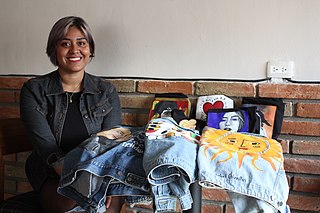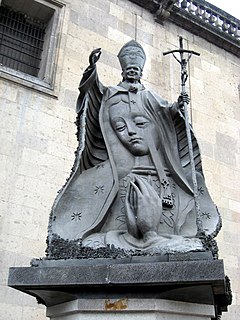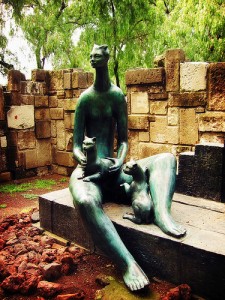 W
WJosefina Aguilar is a Mexican folk artist from Ocotlán de Morelos, Oaxaca. A member of the Aguilar family, she is best known for her small clay figurines called muñecas (dolls), an artform she learned from her mother. Aguilar uses red clay to create depictions of everyday village activities, religious and folkloric scenes, famous figures, and special Day of the Dead statues. Collectors of her work include Nelson Rockefeller, who discovered her work on a trip to Oaxaca in 1975, as well as repeat visitors to Oaxaca who come to see her latest work. Aguilar says each figurine she makes is unique. She became blind in 2014 and now uses touch to create her art. One of her major collectors quoted her as saying "It's not the eyes. It's the hand and the brain."
 W
WFortunato Arriola (1827–1872), born in Cosalá, Sinaloa, Mexico, was a painter of portraits and luminous tropical landscapes that were very popular in San Francisco, California, where he came to live in 1857. The son of a wealthy landowner, Arriola was a handsome, distinguished and cultivated man. He was self-taught as an artist and began his career painting portraits. He had a studio near the corner of Kearney and Clay Streets that was a gathering place for Mexican exiles, a place of intellectual ferment and the occasional brawl. Among his students were Toby Rosenthal and Ransom Holdredge. Most of his works, imagined views of Central America, disappeared after he died. His largest painting, "Sunset in the Tropics" measures about 5 ft. by 7 ft. in its original frame
 W
WÁlvaro Blancarte Osuna was a Mexican painter, sculptor, and muralist.
 W
WIsabel Cabanillas de la Torre was a Mexican artist, and activist.
 W
WFrancisco Cárdenas Martínez also known as Pancho Cárdenas is a Mexican artist. He was born in Iztapalapa, east of Mexico City.
 W
WCarlos Carrera is a Mexican film director and screenwriter. He directed El crimen del Padre Amaro (2002), which was nominated for the Academy Award for Best Foreign Language Film. In 2009, he directed Backyard about the female homicides in Ciudad Juárez, which won a silver plaque at the 2009 Chicago International Film Festival.
 W
WPedro Cerisola y Weber is a Mexican architect who served as Secretary of Communications under President Vicente Fox's administration.
 W
WAtanasio Echeverría y Godoy was an 18th-century Mexican botanical artist and naturalist who trained at the Royal Art Academy in Mexico. The genus Echeveria was named in his honour by Augustin Pyramus de Candolle.
 W
WAngel Sanchez Gas (1933-2015) was popularly known as Gelsen Gas, an alliterative pseudonym. He was a multifaceted and interdisciplinary artist, theater director, film director, film producer, actor, painter, poet, sculptor and inventor, based in Mexico City, Mexico. His career and style are highly diversified and hard to classify. He is most commonly known for his paintings and geometrically constructed artworks. Among his most famous works are the film 'Anticlimax' (1969) featuring Alejandro Jodorowsky, his painting 'Homenaje a Magritte' (1969), an homage to the Belgian surrealist artist René François Ghislain Magritte and his self-portrait 'Autogelsen' (1971).
 W
WAgustín Hernández Navarro is a Mexican architect and sculptor.
 W
WMardonio Magaña-Camacho (c.1865–1947) also known as Magañita, was a Mexican educator and sculptor known for his folk art stone direct carvings, he was also known to work with wood and mud. He was a self-taught artist inspired by nature, that was "discovered" by artist Diego Rivera. It's said that Diego Rivera was quoted as saying Magaña was, "the greatest contemporary Mexican sculptor".
 W
WJavier Marín is a Mexican artist.
 W
WCarlos Obregón Santacilia (1896–1961) was a Mexican art déco architect. He trained at the Academy of San Carlos during the Mexican Revolution. He claimed a distinguished Mexican heritage, as great grandson of Benito Juárez and grand nephew of Alvaro Obregón.
 W
WLuis Felipe Ortega is a Mexican contemporary artist. Since 1993 he has exhibited individually and collectively both in Mexico and abroad. Representative of Mexico's Pavilion in the 56 Venice Biennale in 2015, with Tania Candiani.
 W
WEmilia Ortiz Pérez was a Mexican painter, cartoonist, caricaturist, and poet, best known for her watercolors. Her father, Abraham D. Ortiz, had arrived at Tepic originally from Oaxaca where he married Elvira Perez and engaged in haberdashery and the hardware trade. She studied painting at the Academy of San Carlos in Mexico City. Her drawings and paintings were exhibited in 1940. An author as well, her prizewinning book, De mis soledades vengo, was published in 1986. The Museo Emilia Ortiz in Lerdo houses Ortiz's photography and art, as well as local art.
 W
WMiguel Ángel de Quevedo was a Mexican architect, engineer, and environmentalist who founded Mexico City's Viveros de Coyoacán arboretum, as well as numerous other construction projects in Mexico City, and throughout the country, and promoted the conservation of Mexico's forests. He is called el apóstol del árbol for his dedication to the defense of Mexico's forests.
 W
WGrace Quintanilla was an artist, curator and producer working in the field of new media art and digital culture.
 W
WJosé Sacal Micha was a Mexican sculptor and ceramist born in Cuernavaca, Morelos. His work has been interpreted as surrealistic.
 W
WNunik Sauret is a Mexican printmaker.
 W
WSixto Valencia Burgos was a Mexican cartoon artist based in Mexico City, best known for taking over the responsibility of drawing famed Mexican cartoon character Memín Pinguín. This cartoon was very criticized by the USA media as it was considered racist because Memin, the main character, was drawn with a very gross black racist stereotype.
 W
WCharlotte Mata Rascála (1919–1989) known as Charlotte Yazbek after her husband José Yazbek, was a Mexican sculptor.